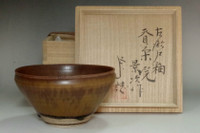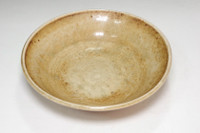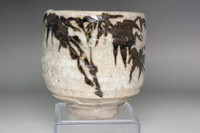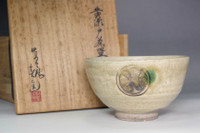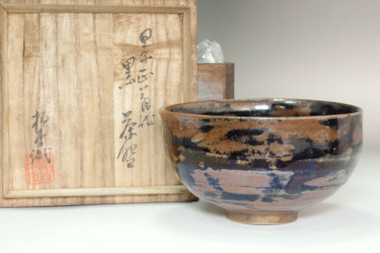 Loading... Please wait...
Loading... Please wait...Currency Displayed in
- Home
- SOLD ITEMS
- Kato Kagemasa (1168-1249) Antique seto pottery teabowl #4842
Categories
Kato Kagemasa (1168-1249) Antique seto pottery teabowl #4842 for sale
Product Description
Up for sale is this "Kato Kagemasa (1168-1249) Antique seto pottery teabowl #4842" If you have any questions please contact us before buy it. No reserve.
- width : approx. 12.6cm (4 61⁄64in)
- height: approx. 7cm (2 3⁄4in)
- weight: 285g (w/box 451g)
- condition: damaged, see photos
- note: carving letters in bowl says Ninji 3 (1242) Kagemasa made, letters in wooden box says judged by Kato Shihakudo.
Kato Shihakudo - Born in Kyoto in January 1872. His first name was Naohiko. He studied under Mochizuki Gyokusen and Kishi Chikudo, and was awarded prizes at the National Industrial Exhibition. He painted the ceiling of the Tokyo Exhibition Hall at the Anglo-Japanese Exposition and twice painted the ceiling of the Kabuki-za Theater in Tokyo.
Kato Kagemasa
1168-1249
male
seto pottery
Toshiro, the founder of Seto-ware
Kato Shirozaemon Kagemasa (commonly known as Toshiro) is essential to the story of Seto-ware. According to Fujishiro’s biography, which describes the life of Kato Shirozaemon Kagemasa, Toshiro followed Dogen Zenji, the founder of the Soto school of Zen Buddhism that founded Eiheiji Temple, to China in the second year of Joh’o 2 (1223), and returned to Japan after learning the technique of pottery. After that, he traveled around Japan in search of suitable soil for making pottery and in 1242, he found good soil in the Sobokai region of Seto and opened a kiln there. Thus, Toshiro became the founder of Seto-ware. Although no biographies of Toshiro have been confirmed prior to the Edo period, several historical documents related to Toshiro existed in the Middle Ages.
The earliest record of Toshiro’s appearance is an iron-glazed pottery tea caddy, marked Seio 2 (1289). The earliest biography of Toshiro is “Kato Toshiro Shunkeio Denraiki” written in 1748. In this biography, Zen priest Dogen visited Mikuzo-in temple in Kasugai from time to time. There, Toshiro visited him and he started practicing Zen Buddhism. It is written that this became an opportunity for Toshiro to follow Master Dogen to China during the Song dynasty.
There are many other biographies of Toshiro, but they are legends and have no scientific support.
In Bunsei 7 (1824), Suehiko Shrine was built in the precincts of Fukagawa as a shrine to Toshiro. In 1867 (Keio 3), Japan’s largest ceramic monument (over 4 meters (13 feet) in height) was erected in memory of Toshiro in Toso Park, which overlooks Seto town. In addition, the people of Seto have been holding the Seto Pottery Festival since 1962, honoring Toshiro as the founder of Seto ware and his achievements.
Sobokai clay
There is a legend that “the potter Toshiro (Kato Shirozaemon) found suitable clay for pottery in Seto, Sobokai, and settled in Seto to make pottery from that clay. The clay is a type of clay called Kibushi-nendo, which is characterized by its fine texture, high viscosity, and ability to keep its shape. This clay, which contains a lot of iron and turns reddish-black when fired, is thought to have been especially suitable for the production of tea utensils because it enables thin construction and complex deformation by the potter’s wheel, and it is also strong when fired.
It is known that the Owari clan had a monopoly on Sobokai clay by bringing it into the castle’s storehouse. At one time, pottery tea utensils were so expensive, Samurai said that a castle could be built with a single tea utensil. Later, it became less expensive and there were many Seto-ware tea utensils made of Sobokai clay.
shop policy
AppraisalWe are a very small team with limited resources and are unable to conduct scientific age verification or appraisals by the artist’s descendants. We evaluate items using specialized reference books, scholarly resources, and knowledge inherited from senior experts in the field. If a purchased item does not meet your expectations, please feel free to contact us. We sincerely value your opinion.
Cancellation and Return
We accept return only if you contact us within 30 days after you receive the items. Return-shipping costs are the buyer’s responsibility. If you ask a cancellation before shipping the package, we may ask a 20% restocking fee.
Shipping
+ Shipping to the USA, Europe, and Asia is free. For other areas, please contact us. Shipping is via EMS or DHL.
+ VAT is not included in the item price.
+ We will ship within 3 business days. Shipping time is usually around a week.
Insurance
We are not responsible for delays, returns, damage or loss due to customs or postal processing. EMS is insured (the amount on the label is the guaranteed amount). If you choose DHL, we recommend that you purchase additional insurance. Please note that if you choose the DHL drop service option, insurance will not be applied.
Taxes
Import duties, taxes and fees are not included in the item price. If your country requires customs duties, etc., it is your responsibility to pay them.
To customers buying tableware
Our products are mostly used. We sell them in the same condition they were purchased, please be sure to clean them thoroughly before actually using them.

